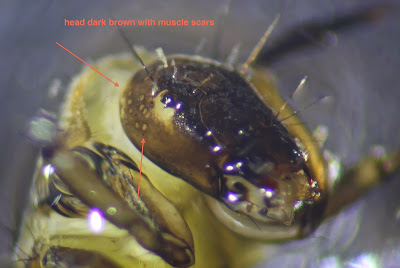Friday, December 27, 2013
Neophylax fuscus in Buck Mt. Creek? Possibly another Uenoid we've not seen before
This should be the main story today -- I've finally found our third species of large winter stonefly, Strophopteryx fasciata. I was quite sure I'd find them in Buck Mt. Creek once the water subsided and cleared, and sure enough I picked up several today. This is late. I normally see them at the start of December. But everything seems to be late in starting this year. Still rather small...
but when they mature they look something like this: mottled head and nota; banded abdominal terga.
___________________
But for the main event -- we have another Uenoid (little northern case-maker) which requires identification.
I was expecting to see Neophylax oligius larvae in Buck Mt. Creek, the species I've found here before. But look at that face -- no pale frontoclypeal stripe whatsoever. Up close, it's dark brown to black with muscle scars at the rear.
There is also, from what I can see, no tubercle on top of that head, and it became clear with a microscope view that this is a species without clavate ventral gills. Note.
No gills that stick out like this.
So, what do we have? Looking at Beaty ("The Trichoptera of North Carolina," pp. 86-87) the possibilities would seem to be N. aniqua, N. concinnus, N. toshioi, and N. fuscus. N. aniqua and N. toshioi have tubercles that are easy to see, and a "short median tubercle" is often found on N. concinnus as well (Vineyard, et.al., p. 46). And there's another problem with N. concinnus for the ID: the ventral sa3 positions on segment 1 have 2 to 4 setae. Note the numerous setae at sa3 on the larvae I found.
So have we found N. fuscus? Beaty's description of this species is brief: "without clavate ventral gills on abdominal segment 2; large blade-like spines on anterior pronotum; head dark brown to black with light muscle scars. Occurs in northeastern Mountains and clean headwater streams to the Tar River.... Relatively rare." I'm not sure about the spines on the pronotum, but the rest seems to fit. And there are two other points made in Vineyard (p.24) that lead us in this direction. 1) "Abdominal segment I with ventral sa3 bearing 6 to 9 relatively long stout setae" and 2) Neophylax fuscus is the species in the genus best adapted to warm water conditions. In streams where it occurs with other Neophylax species, it always occupies the farthest downstream zone in the longitudinal gradient of species." The setae at sa3 on our larvae are long and stout -- I count about 10, and Buck Mt. Creek seems to be the kind of habitat herein described.
Neophylax fuscus is attested in the state of Virginia (Oliver S. Flint, Jr., Richard L. Hoffman, Charles R. Parker, "An Annotated List of the Caddisflies (Trichoptera) of Virginia: Part II. Families of Integripalpia, Banisteria, 31 (2008), pp. 3-23). These authors note: "The scattered records of this species show a distribution almost as large as that of N. concinnus: eastern North America from Minnesota to Nova Scotia, south to Missouri and northern Alabama. The Virginia records are from the Blue Ridge west through the Alleghanies. In contrast to most species of the genus, it prefers larger, warmer, lowland streams in these regions. Fairfax, Giles, Highland, Montgomery, Page, Pulaski, Rappahannock, Wythe cos."
Could be Neophylax fuscus. But I'll probably check in with Beaty to see if he has time to give these a look. More pictures -- dorsal views.
_________________
Other discoveries this morning.
1) Large winter stonefly, Taeniopteryx burksi/maura. Fairly large by now.
2) Small winter stonefly, Allocapnia pygmaea.
3) And our little pebble case-maker in the cornucopia, hooded case: Apatania incerta.
May the good weather continue!
Subscribe to:
Post Comments (Atom)















No comments:
Post a Comment